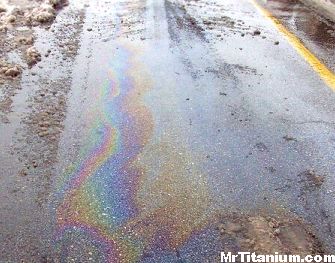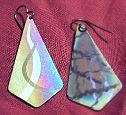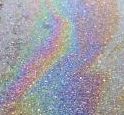
|
Titanium, a refractory metal, is at least as strong as steel, but 45% lighter and won't rust. It is twice as strong as aluminum, but only 60% heavier.Titanium keeps its strength at high temperatures, up to red-hot where steel slumps and aluminum is liquid. For artistic uses, the refraction of light through a sub-micron
thickness of clear oxide on the surface produces interference pattern
colors similar to the colors produced by
oil on water.
Get all the technical stuff at webelements.com Titanium is a Refractory Metal: It has a very high melting point. |
|
| Name origin: | Greek: titanos (Titans) |
| Description: | Shiny, dark-gray metal. It can be highly polished, and is relatively immune to tarnishing. |
| Rarity: | Titanium is present in meteorites and in the sun (Titanium oxide bands
are prominent in the spectra of M-type stars). Some lunar rocks contain
high concentrations of the dioxide, TiO2.. Fortunately, it is also the 9th most abundant element in the earth's crust (5700 ppm), and 4th most common metal (after Aluminum, Iron, and Magnesium). |
| Discovered by: | It was discovered in 1791 in its oxide form by an Englishman, William Gregor, and later rediscovered as one component of the oxide rutile and dubbed "Titanium" by the German, Heinrich Klaproth. Not commercially refined until the 1920's. Barely used until the cold war and the space race created a demand for it. |
| Sources: | Usually occurs in the minerals ilmenite (FeTiO3) or rutile (TiO2). Also in Titaniferous magnetite, titanite (CaTiSiO5 = CaTiOSiO4), and iron ores. |
| Purification: | The elemental metal was not made until 1910 by Matthew A. Hunter. Pure metal is currently produced by heating TiO2 with Carbon and Chlorine gas to produce TiCl4 which is then heated with Mg gas in an Ar atmosphere in an explosive reaction at 800°C (1472°F). |
| Mainstream Uses: | Used in many alloys for corrosion resistance, strength, and temperature
tolerance. Favored material for prosthetic implants because of its extreme
hypo-allergenic nature. Titanium dioxide (TiO2), a white pigment in paint, rubber, paper and many other places. |
| Artistic Uses: | The artistic possibilities of controlled colors from light wave interference/cancellation in the clear refraction layer on titanium began in the late 1970's in England. Colors are produced by heating the metal in the air, or by electrically anodizing it in an electrolyte to bond oxygen to the surface of the metal. |
| Grades Available: | Click here for a list of some of the common grades of titanium |


